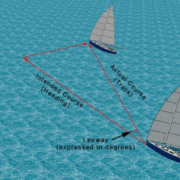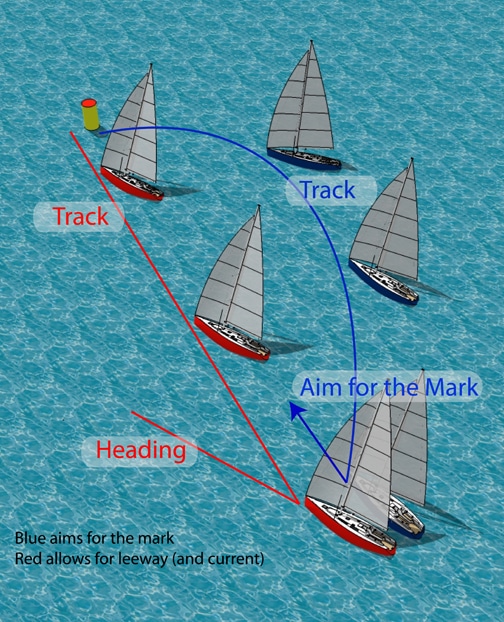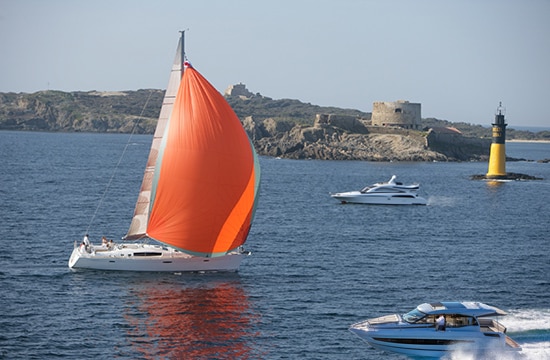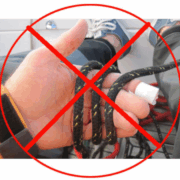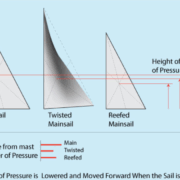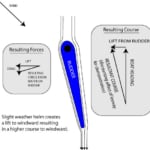Leeway and a Bottle of Rum
Leeway is just one of those things that is a law of the universe that we have to put up with. It’s just like gravity. Still with gravity – the advantage is that it’s highly predictable. And so then is leeway.
Leeway is the sideways slip motion of our sailboat downwind from the pressure of wind against our boat and sails. It results in a course that is less than desirable.
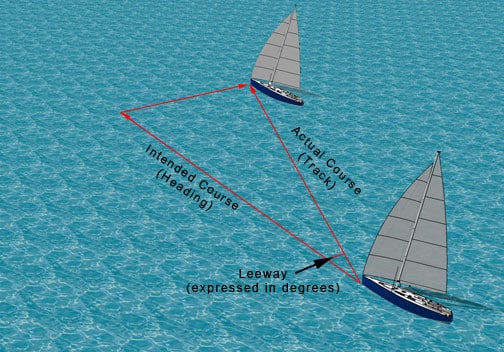
Leeway Slips Your Boat Side Ways Down Wind
Airplanes suffer from the same issue. When flying in a crosswind, the plane crabs (slide slips) downwind. The course becomes different from the heading.
Not accounting for leeway will have you sailing (or flying) in a fairly unnoticeable arc to get to the mark. To represent an example with a mark to the north and a westerly crosswind, here’s what happens; you aim for the mark at 000, and your boat slips sideways to the west. Now your mark is at 359 but you don’t really notice it. After a few minutes, your mark is at 358 still in notice. Minutes later your heading is 355 then 350 etc. All because you keep aiming at the mark but you’re being pushed to the east by the wind. Your course over the ground becomes an arc and is the long way around.
The prudent sailor will account for the leeway and sail a constant heading depending on their known leeway of say 350 for the example above. The sideways slip motion will deliver them to the mark in a straight and shortest line.
Now that we’re in the electronic age, navigators will plug in the destination to the GPS. The autopilot which is cross-talking to the GPS takes care of the rest. The GPS analyses the cross-track (the boat’s distance away from a straight line to the mark) and feeds back to the autopilot the proper heading to minimize this in real-time. Thus resulting in a straight course to the mark.
I’m doubt that during the Wednesday/Friday night beer can race such electronic methods are utilized. So I’m suggesting that to take line honors and win the bottle of rum at your club race by taking account of leeway.
Leeway is particularly more prevalent when you are sailing on a close haul or close reach and can be as much as 20 degrees depending on the wind conditions, water conditions, your sailboat design, your apparent angle with the wind and how your sails are set.
However, other than buying a new boat, the only thing that you have control over is the trim of your boat and sails.
Here’s a couple of general rules to follow:
- Over sheeted sails cause more sideways force and thus sideways slip (leeway). Fly the telltales diligently.
- Aim for a position to windward of the mark you’re trying to go around. The more you are sailing on an upwind course, the more the degrees upwind you should aim.
- The higher the wind speed, the higher above the mark you should aim.
- In general, on a close haul, allow 10-15 degrees. Adjust this less if the wind is light, more if the wind is strong. Reduce this amount linearly as you bare away from the wind.
- Make sure your boat is trimmed with slight weather helm.
When doing serious navigation we absolutely must account for leeway and an excellent understanding of how your boat performs leeway wise is essential and how to solve for it once you know it. NauticEd developed an educational navigation video solving a leeway and current exercise.
Using a gps and a nice steady windy day, you can do a simple determination of your sailboat’s typical leeway.
(1) Begin sailing on an angle slightly off a close haul direction and with a recognizable land marker dead ahead.
(2) Measure your speed
(3) Douse the sails and begin motoring at the same speed in exactly the same direction.
(4) Take note of your gps course.
(5) Deploy the sails and turn off the engine.
(6) Continue to aim for the same point on land.
(7) Now read out your gps course.
(8) The difference in course angles will be your leeway
(9) Repeat for different points of sail
(10) Repeat for the opposite tack.
(11) Repeat on different days with different wind strengths
Note that:
(a) this method is relatively immune from current because you have normalized it out by performing the motoring task.
(b) this method will not account for the leeway due to the hull of your boat presented to the wind.
We hope you enjoy your bottle of Rum!

